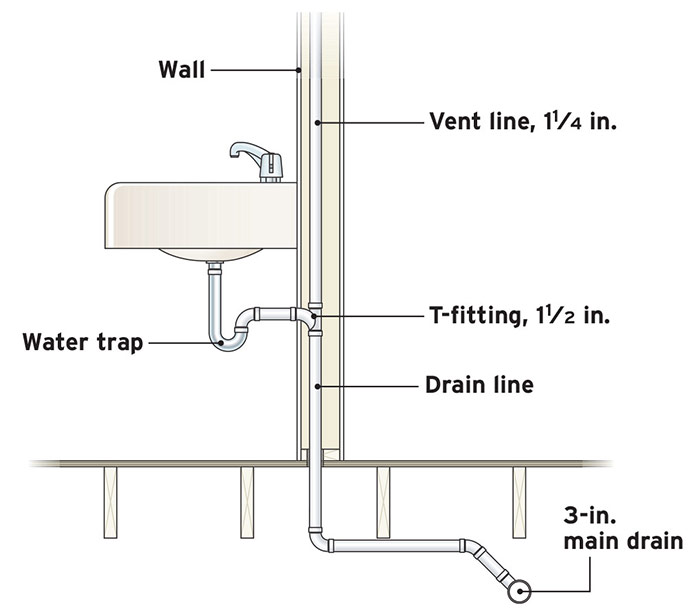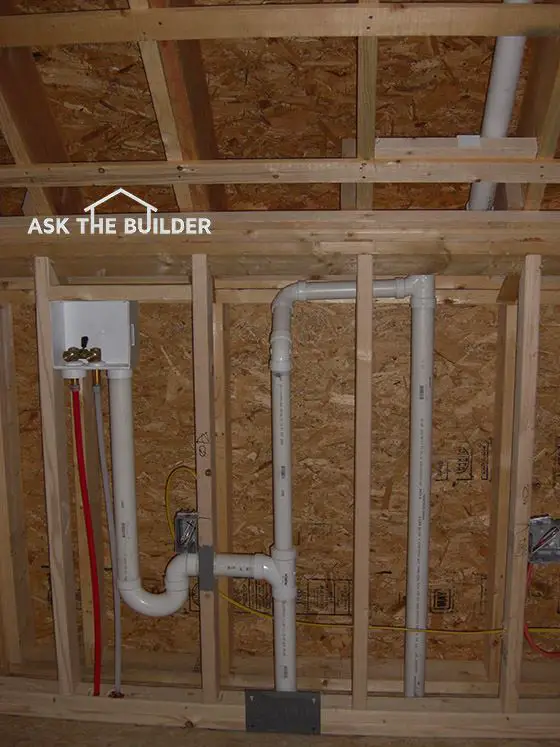Adequate Ventilation in Plumbing Systems: How It Matters
Adequate Ventilation in Plumbing Systems: How It Matters
Blog Article
Every person has their unique way of thinking involving Why Plumbing Air Vents Are Important.

Proper ventilation in plumbing systems is commonly forgotten, yet it is important for preserving the performance and safety and security of your home's plumbing. Ventilation aids regulate atmospheric pressure, prevent the build-up of damaging gases, and guarantee the efficient elimination of waste. In this overview, we will certainly explore the relevance of correct pipes air flow, how it works, and the benefits it gives your pipes system.
Understanding Ventilation in Plumbing
Air flow in plumbing describes the network of pipelines that permit air to flow with the water drainage system. These vents offer several purposes, including regulating atmospheric pressure within the pipelines, protecting against sewage system gases from getting in the home, and assisting in the smooth flow of wastewater.
Exactly How Ventilation Functions in Pipes Solutions
Air Pressure Law
Proper ventilation preserves balanced atmospheric pressure within the pipes system. When water moves through pipes, it displaces air. Without sufficient ventilation, this displacement can develop adverse stress, leading to reduce drains or siphoning of water from traps, which can create undesirable odors to seep right into the home.
Stopping Sewage System Gas Accumulation
One of the most important functions of plumbing vents is to prevent drain gases, such as methane and hydrogen sulfide, from building up within the home. These gases can pose severe wellness threats and are highly flammable. Vent pipelines allow these gases to leave securely outside.
Aiding in Waste Removal
Air flow aids in the effective elimination of wastewater by stopping airlocks in the water drainage system. When air can stream openly through the vents, it allows water and waste to stream smoothly via the pipelines, reducing the risk of clogs and back-ups.
Types of Pipes Vents
Key Heap Vent
The main pile vent, additionally called the vent stack, is the main air vent in a plumbing system. It extends from the primary drain line up through the roofing, permitting gases to escape and fresh air to enter the system.
Branch Vent
Branch vents attach to the major pile air vent and offer specific fixtures, such as sinks, commodes, and showers. These vents make certain that each component has ample ventilation to function properly.
Air Admittance Shutoff (AAV).
An Air Admittance Valve (AAV) is a one-way shutoff that permits air to enter the pipes system without the requirement for a conventional vent pipe extending with the roofing system. AAVs are commonly made use of in restorations or areas where setting up a conventional vent is impractical.
Indicators of Poor Ventilation in Pipes.
Slow Draining Fixtures.
If your sinks, bathtubs, or bathrooms are draining pipes gradually, maybe a sign of poor ventilation. Poor air flow can produce a vacuum cleaner result, making it challenging for water to drain effectively.
Gurgling Appears.
Gurgling noises coming from drains are often a result of air being sucked with water traps because of negative pressure in the pipelines. This is a clear sign of insufficient air flow.
Unpleasant Smells.
Drain odors inside your home are a warning that your pipes system is not correctly aerated. This could imply that sewer gases are not being appropriately vented outside, bring about potentially unsafe conditions.
Common Ventilation Mistakes.
Poor Vent Sizing.
Using undersized air vent pipelines can lead to bad air flow and pressure inequalities in the system. It's important to use vents that meet the details requirements of your pipes system.
Improper Vent Placement.
Putting vents as well much from the fixtures they offer can minimize their efficiency. Correct placement ensures that air can flow freely and efficiently via the system.
Ignoring Code Needs.
Building regulations offer specific standards for plumbing air flow. Overlooking these codes can cause a system that fails to operate appropriately and might bring about expensive repair work or carcinogen.
Advantages of Proper Ventilation.
Enhanced System Performance.
Properly ventilated plumbing systems run more effectively, with fewer obstructions, faster draining, and less strain on the pipes. This efficiency extends the lifespan of the plumbing system.
Improved Air Quality.
By protecting against sewage system gases from entering your home, proper air flow contributes to much better indoor air top quality, making your living atmosphere healthier and a lot more comfy.
Avoiding Water Damages.
Ample ventilation aids prevent water from being siphoned out of traps, which can lead to sewer gases entering the home and causing water damages with time.
Actions to Guarantee Proper Air Flow.
Consulting Plumbing Codes.
Always speak with local plumbing codes when creating or changing your pipes system. These codes supply the essential standards for proper venting and guarantee your system fulfills safety and security criteria.
Regular Evaluation and Maintenance.
Normal assessments can aid identify potential air flow problems prior to they come to be significant problems. Upkeep tasks, such as cleansing air vent pipes and checking for obstructions, are crucial for keeping the system in good working order.
Specialist Installment.
For new setups or significant adjustments, it's smart to employ a specialist plumbing technician. They have the competence to guarantee the air flow system is properly designed and installed according to code.
Final thought.
Proper air flow is an important element of any kind of plumbing system, guaranteeing that it works efficiently and safely. By recognizing the value of air flow, acknowledging the signs of inadequate ventilation, and taking steps to preserve your system, you can avoid costly issues and shield your home's air quality.
4 Things You Should Know About Your Plumbing Vents
What Plumbing Vents Are
Also called a vent stack, a plumbing vent is a vertical pipe attached to your drain line that runs through your roof. The plumbing vent pipe, or plumbing air vent, removes gas and odors from your plumbing system and allows fresh air to enter the pipes, helping the water to flow out of the drain pipes.
What Plumbing Vents Do
Plumbing vents have two basic functions. One of which is to allow unpleasant smelling wastewater and sewer gasses to escape your plumbing system instead of entering your home. Plumbing vent pipes are typically located on roofs, away from windows, to ensure the fumes exit the home completely.
The other function of the plumbing vent is to move fresh air into your plumbing system. This helps move water through every plumbing fixture in your house, like toilets and sink drains. Think of the way in which you need to let a little air into the bottle as you pour soda in order to make the drink flow smoothly.
Different Types of Plumbing Vents
True vent: This is the most common vent option. In simplest terms, a true vent is a vertical pipe attached to your drain line that exits through the roof. They often function as the main vent that other fixtures can connect to. Re-vent pipe or auxiliary vent: Attached to the drain line near specific plumbing fixtures, re-vent pipes run up and over to connect to the main vent. Common vent: Two plumbing fixtures installed on opposite sides of a wall are typically tied into the vent stack using something known as a sanitary cross. Wet vent: This venting option operates as a drain pipe and a vent at the same time. Wet vent drainage systems drain water from one fixture while venting the air from another. Although they’ve been used for over 100 years, wet vent systems have only recently been added to the plumbing code in many areas. If you’re planning on installing one in a bathroom remodel, make sure you check your local code prior to construction. Loop vent: For free-standing fixtures like kitchen island sinks, loop vents are ideal. These vent pipes run under the floor, rise from the P-trap, and create a loop inside the cabinet sink. Air admittance valve: An AAV is a one-way mechanical valve typically installed at the site of the plumbing fixture. AAVs allow venting to occur without having to tie into a larger venting system. They’re ideal for venting fixtures where you aren’t able to easily connect to an existing vent system. Common Plumbing Vent Issues
Although vent pipes typically don’t have water flowing through them, they’re still subject to many typical plumbing issues. For example, clogs are one of the most common problems associated with sewer vent pipes. If your vent pipe gets clogged, all of your plumbing fixtures tied into the vent stack will be affected.
A sink with a slow drain that bubbles and gurgles or a strong sewage smell around your toilet are both indicators that your toilet vent pipe is clogged. Because most vent pipes exit through the roof, old leaves, twigs or even a bird’s nest could be clogging the pipe.
Clogs in your vent pipe system cause a buildup of negative pressure, meaning that water won’t be able to flow out of your home very well. It’s similar to putting your finger over the opening of a straw to trap water inside. When you remove your finger, the water is able to flow out of the straw.
If you suspect you have any blockage in your vent, make sure you have a professional come examine the situation. Left unchecked, a blocked air vent can lead to other costly repairs, like leaks and sediment buildup.
Under Pressure
Pipe vents are essential aspects of a home’s plumbing system. Owning a home means learning about all sorts of things you never put much thought into before. But by understanding as much as you can about the important systems of your home, you can keep those budgets intact and those anxiety levels low.
https://www.homeserve.com/en-us/blog/home-improvement/plumbing-vents/

We are very inquisitive about Why Plumbing Air Vents Are Important and I hope you enjoyed our entry. Are you aware of another individual who is very much interested in Essential Plumbing Vent Pipes: Understanding Their Role? Why not promote it. Thank you for your time invested reading it.
Click Here Report this page